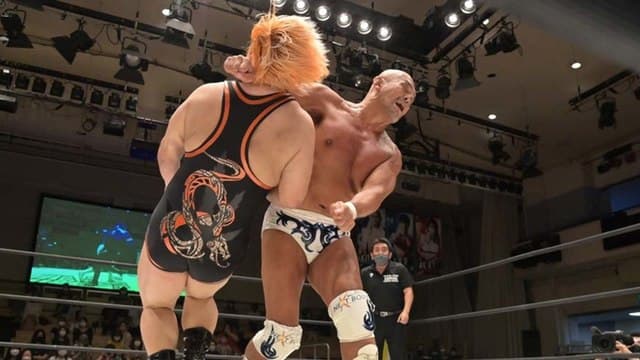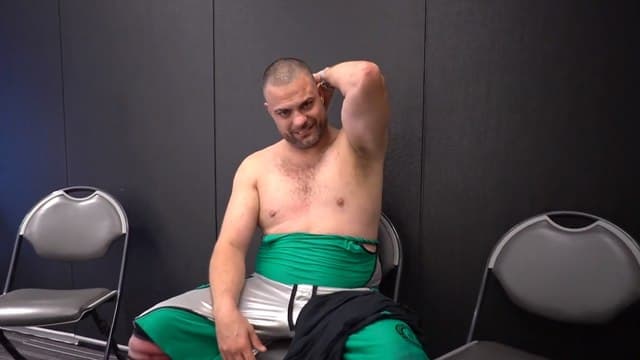[Note: This interview has been edited for length and clarity.]
Atsushi Onita is one of the most influential wrestlers over the past 30 years of wrestling in the United States of America. In that same stretch of time—and you can go back to the end of his 1981-1982 North American excursion that took him from Memphis to Florida to Mexico if you like—he’s wrestled four times in this country: 1992 under the banner of his own Frontier Martial-Arts Wrestling, 1998 for Extreme Championship Wrestling, and in 2017 (albeit in a limited capacity) and 2018 for Combat Zone Wrestling.
If it seems strange to credit Onita with so much impact on the landscape of American wrestling, consider the way former AEW World Champion Jon Moxley changed his theme music to the same version of “Wild Thing” that Onita walks out to the ring to after participating in one of Onita’s trademarks, an exploding barbwire timebomb deathmatch, which Onita helped to promote. Consider how many streetwear-influenced, small batch, fan-pressed t-shirts bear the emblem of his promotion. Years of tape trading. Innumerable views on YouTube.
More Professional Wrestling:
- Apocalyptic Wrestling: The Self-Sacrifice of Atsushi Onita
- A Jushin Liger vs. Brian Pillman Match Trapped 90s Fandom In Amber
- Booker T, the Glass Ceiling, and Life Lessons of Being a Black Wrestling Fan
More than that, Atsushi Onita’s FMW—its hardcore, spectacle-driven style, its rough-hewn characters, its Memphis-derrived sense of heightened reality, all of which distinguished it from New Japan Pro Wrestling and All Japan Pro Wrestling—was a big influence on Paul Heyman’s vision for what wrestling could look like outside the auspices of America’s number one and number two wrestling promotions. As the story of the Monday Night War goes, when WWE was in need of an edge due to the temporary dominance of WCW, they borrowed from ECW, and vice versa, in effect borrowing from FMW, Memphis, and wherever Memphis borrowed its ideas.
If that influence is difficult to see it’s because influence in professional wrestling is never 1:1. Had Mick Foley succeeded in convincing Vince McMahon to promote an exploding ring match at Terry Funk’s Double Cross Ranch at WrestleMania, this might be a different conversation, but instead we got a dumpster match. If ECW’s test runs with explosion matches had been better, this might be a different conversation. If any of the various indie promotions whose ideas for explosion matches or alliances with Onita had produced something more than vapor, this might be a different conversation.
To date, the closest thing we have to a 1:1 realization of what Onita is most known for was AEW’s attempt at his match at Revolution, which ended with the timebomb fizzling as Eddie Kingston covered up his friend-turned-enemy-turned-friend-again Moxley to protect him from a shower of sparks too weak to impress in a ring entrance, let alone a deathmatch.

As if in response to these attempts to reach the same heights he did, the 63-year-old Onita is returning to the exploding ring deathmatch, under a familiar flag. FMW-E (the “E” is for “Explosion”), his new promotion, launches on July 4 (in Japan—the event starts at 11:00pm EST on July 3 in North America) with a show called “Independence Day,” featuring a six-man tag team “Deathmatch of Hell” where he, FMW stalwart Ricky Fuji, and Minoru Fujita will wrestle Abdullah Kobayashi, FMW alum Onryo, and Yuko Miyamoto in a match with unique stakes. To wit, if Onita loses, he will blow up the leather jacket he’s known for wearing to the ring, and if Kobayashi loses, he will blow up his motorcycle.
With that show on the horizon, I was granted an opportunity to ask the deathmatch icon about FMW-E’s debut, his match, and his career.
FanFyte: FMW-E debuts on July 4 with “Independence Day,” and the show’s posters feature the American flag. What is the connection between the American holiday and your return to explosion matches?
Onita: Until FMW was established, the major promotions All Japan Pro Wrestling and New Japan Pro Wrestling dominated the Japanese professional wrestling market. FMW, which I founded, was called “indie” in contrast to them, and the word “indie” was made famous in Japan by FMW. By “indie,” I mean “independence,” which is a keyword to understanding what I want to do. If you belong to the big party, you know, you can’t fight city hall. You can’t do what you want.
That’s why I decided to use the word “indie” or “independence” for the title of the FMW-E launch show, and I associated those words with July 4. An explosion match associates itself with the fireworks of July 4, doesn’t it?
Is it still a goal of your’s to bring your version of the explosion match to America?
I want to show American fans my original explosion match. I sometimes feel like I have to. American deathmatch fans have been disappointed twice, first with the explosion deathmatch CZW held in 2017, and secondly AEW’s. At the time of the CZW show, maybe because of costs, CZW said “we don’t need Japanese engineers, don’t worry, leave it to us,” and I believed them.
I sent a cheering message to Kenny Omega and Jon Moxley, but AEW did the preparations for their explosion match on their own, and I wasn’t involved at all. However, I was disappointed that the fans were disappointed, and I felt responsible.
Since that match, Moxley has taken to entering the ring to your theme music. Is it at all strange that your influence on American wrestling is still so profound in 2021?
Jon Moxley uses my theme music? Thank you, Moxley. I think if he has a spirit of JADO (evil ways), we might stand in the same ring some day. It would be interesting, wouldn’t it?
When other wrestling companies produce explosion matches, they often struggle to live up to the spectacle established by FMW in the 1990s. What is so difficult about this kind of match?
We took small steps towards the original explosion deathmatch. FMW could not have a big one at first. After many trials and errors, we can do the explosion deathmatch today. Nobody can do it well their first time.

The blast bat has become as much a part of your image as the explosion match. How was it created?
As you know, my first idea was the no ropes barbed wire explosion deathmatch. But it costs too much money to produce on a show in the countryside, so I scaled it down.
The FMW name has returned many times since its original closure in 2002. How will this version of it distinguish itself from the others?
FMW-E is the only one I am responsible for since I created the first FMW. Except for those, while other promotions have had the FMW name, I wasn’t the key person—I just wrestled for them. But FMW-E is completely different. My opinions and ideas are reflected in it. FMW-E specializes in hardcore wrestling and explosion deathmatches. I think you won’t find a wrestling promotion like it anywhere else in the world, which is why I’m so excited!
Your explosion matches against the likes of Terry Funk and Hayabusa are famous for their conclusions, where you rush back to the ring to save your opponent and the referee by throwing your body on top of theirs. What inspired you to save them?
Even though they were my opponent, I felt for them like they were my brothers, and I felt a sense of respect for them in the ring. That’s the reason.
One of the more incredible aspects of your career was that, in 2002, you wrestled a series of exhibition matches in Afghanistan, during the early stages of the United States’ war there. What was that experience like?
When I showed my wrestling to children in Afghanistan, many of them were enthusiastic and smiled, despite the anxiety of the war. I’m surprised how deeply this memory is burned into my heart. How bright their smiles were! The young minister came to me and said “thank you from Afghanistan.”
Do you still think that wrestling can help others?
I believe in the power of pro wrestling. We can express passion, comedy, sadness, and courage through it. Wrestling can give people courage, relieve stress, and make them smile.

Outside of wrestling, you recently became a coffee sommelier and began selling coffee beans through mail order. What attracted you to the art of coffee?
The coffee business is run by volunteers. We started it because we wanted to create a job to support the employment of people with disabilities. I am grateful to have friends who also contribute as volunteers. As for the coffee, we are very particular about the quality of our beans. High quality coffee beans are carefully selected and roasted, which costs money and takes time and effort. But I’m happy when our customers say it’s delicious!
Any advice on brewing the perfect cup?
Just have fun finding the best way to brew coffee for you.
Since 2020, you’ve been very active in DDT, which doesn’t have a reputation as a hardcore wrestling promotion. Did you have to adjust to that setting at all?
There is a big difference between DDT and FMW-E. I mean, a different point of view, hardcore spirit or not. DDT is kind of a big wrestling promotion. The parent company of DDT is quite a famous company in Japan, and they have the financial resources to pay for production and live streaming like a TV company. I went there because I was thinking of ways to raise the name recognition of the explosion deathmatch to a younger generation by fighting in the DDT ring.
Your upcoming match against Abdullah Kobayashi is unique in that both of you have wagered items of a personal nature. Can you explain the significance of the leather jacket that you stand to lose if Kobayashi defeats you?
We bet our most important things when we fight in must-win matches, don’t we? This is that must-win match. We should wager something that makes us fight seriously. We should go out on that limb.
At this point in your career, why go out on that limb?
The big reason is that I am just curious about his style of deathmatch. Kobayashi is one of the most famous wrestlers of Big Japan Pro Wrestling. I think the deathmatch style of BJW and my style of deathmatch are different in nature and in spirit. Wrestling him is meaningful to me because it’s like a conversation—two kinds of wrestling dialoguing in the ring.
FMW-E’s “Independence Day” broadcasts on July 3, with English language commentary at 11:00PM EST. The stream can be purchased for $9.99 through FMW-E.


